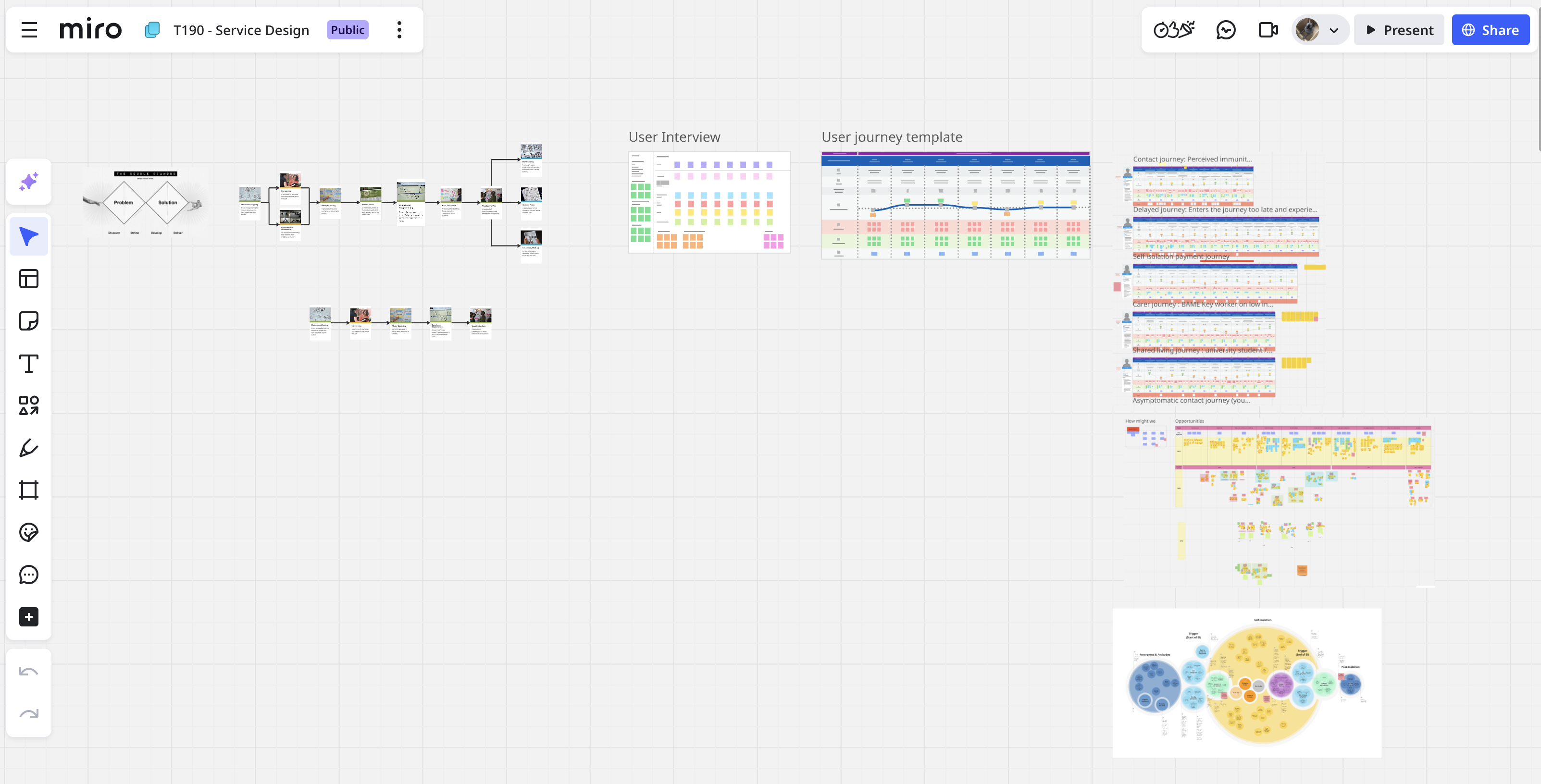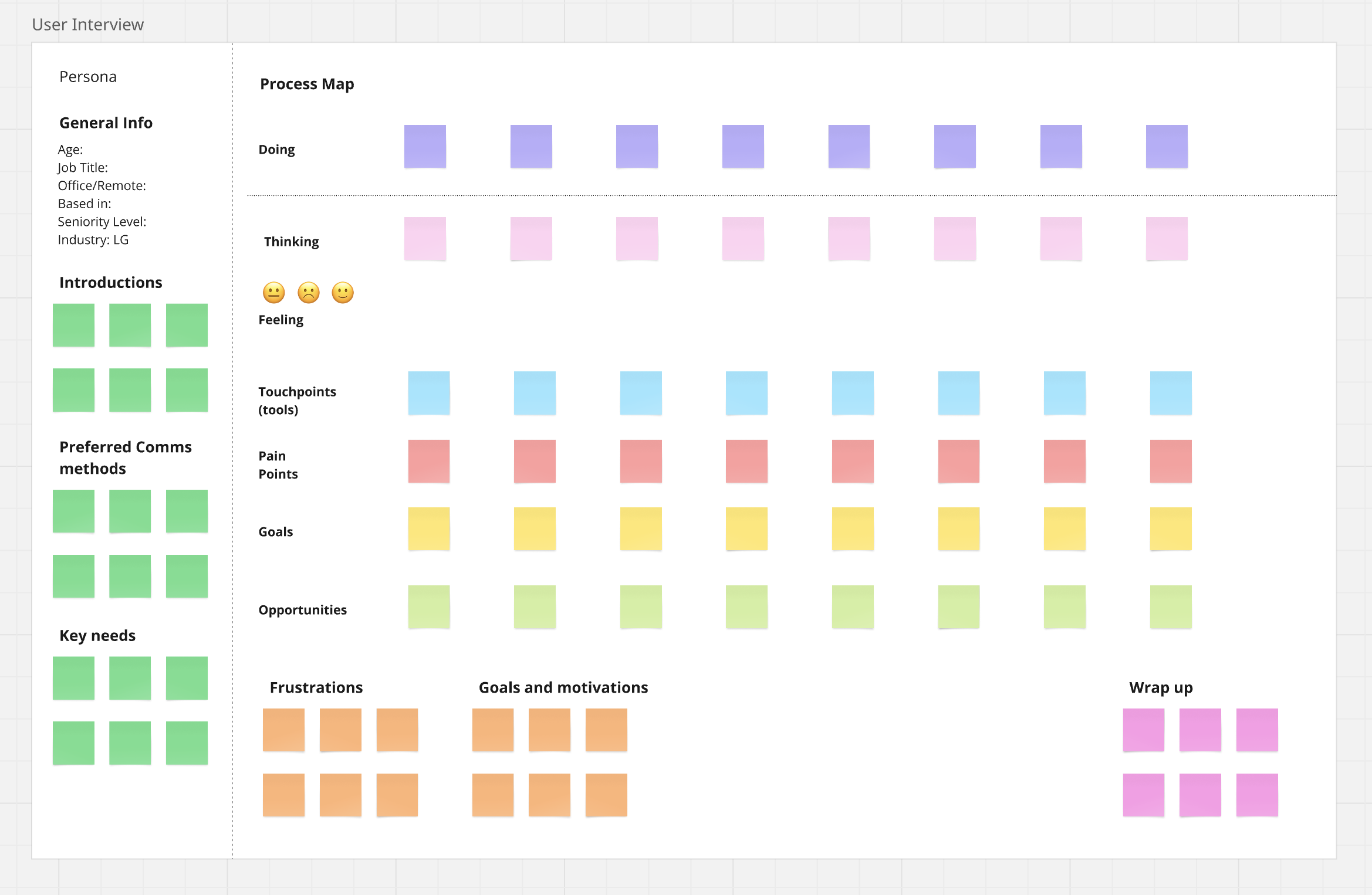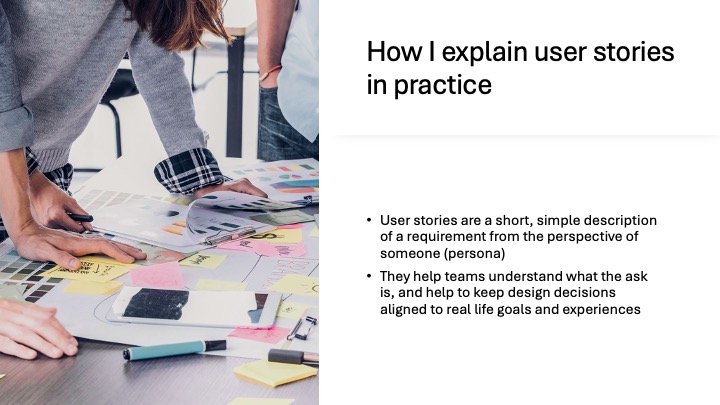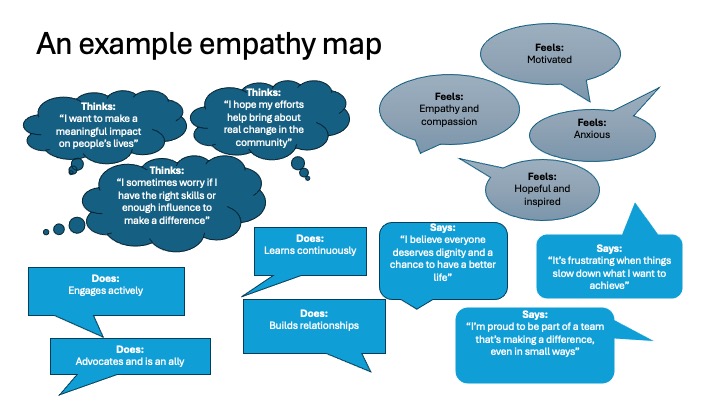By Rachel A. Wood & Samantha Osys.
Earlier this month, we had the pleasure of co-teaching a session on Service Design in Practice as part of the Open University’s T190 module. As both PhD researchers and service designers, we wanted to offer students a real-world perspective on how service design unfolds in practice. The session was a mix of sharing our experiences, using practical tools, and having an honest conversation about the challenges and rewards of working in the field.
We split the session into three parts: Sam kicked things off with a live Miro whiteboard walkthrough, Rachel followed with examples from her own work, and then we wrapped up with a lively Q&A session. The energy and interaction from the students made it an engaging and insightful hour for all of us.
Part 1: Sam on Practice and Process
We began by introducing ourselves. Sam shared a bit about her role as a service designer in the banking sector and her PhD research with the Open University, which focuses on ethics in design practice.

For this section, Sam used Miro, a virtual whiteboard, to walk students through some of the methods she uses in her day-to-day work. She explained the Double Diamond framework, which is the preferred Design framework in most organisations she has worked with. She also introduced methods from the LUMA Institute and human-centred design, which are key to how she works.
One of the main points Sam made was about how we communicate our work to stakeholders—especially as many often say they don’t “get design.” She shared one of her go-to tools, the “Frankenstein” journey mapping template that she created a few years ago. It combines three methods: interviewing, experience diagramming, and ‘Rose-Thorn-Bud’. It’s a handy template for when time in a project is tight – so always!

Sam also shared two examples to bring things to life. The first was a project where two colleagues asked for help using LUMA design thinking methods to understand why employees were volunteering outside the organisation rather than using internal schemes. Sam helped them build a workshop to explore the issue using design thinking methods.
The second example came from Sam’s work on the NHS Test and Trace programme during the COVID-19 pandemic. The project aimed to improve communication around self-isolation, and it was one of those amazing projects that one remembers throughout one’s career. However, this experience also highlighted how service designers must adapt quickly, collaborate under pressure, and keep iterating when global catastrophes, such as a pandemic, happen.
Part 2: Rachel on the power of service design tools
Next up, Rachel talked about her background and passion for service design. Her journey with the profession started in the 1990s when she worked with ITIL (IT Infrastructure Library), and she has been a design leader since 2014. Her part of the talk was based on personas, user stories and empathy mapping. Like Sam she has also been doing a design PhD since 2022.

Rachel decided to talk about these tools, as they are all incredibly important for ‘giving voice’ and making sure the human remains central to the design process. They are something which she focuses on a lot in her practice and industry life. She also made the point that they are strong story telling methods when collaborating with stakeholders, and she often refers to them as ‘what matters to me’ or the ‘manual of me’ (in other words the beneficiaries of the service).

She talked through this with examples related to volunteering and how these examples are documented in both narratives and canvas artifacts. It was also explored how these design contributions can be transformed into implementation and development activity.
The Power of Presentation Methods: Why We Chose Different Tools
One of the key decisions we made when planning this session was to use different presentation methods. Sam went with a Miro whiteboard, while Rachel used a slide deck. Why? We wanted to show students that there isn’t just one “right” way to present ideas in design practice. What matters is the story you’re telling and how you tailor the communication for your audience.
In our experience, the format, whether it’s a digital whiteboard, slides, or something else is just a tool, but what’s important is how you tell the story. When collaborating with stakeholders, especially in environments where design isn’t fully understood, it’s vital to adjust how you present ideas. Sometimes a Miro board is ideal for brainstorming and collaboration, while a slide deck can be more structured and digestible.
We wanted to make this point clear that presentation methods should be flexible depending on your audience and the context. A good designer knows when to adapt their approach to make sure the message gets across.
Shared Takeaways: Four Reflections from Practice
At the end of Rachel’s presentation, we shared a slide with our four key takeaways for the session. These points came from our own practice and reflected what we’ve learned over the years:
- “Rough and ready does the job.”
You don’t need to create high-fidelity artefacts or presentations. Sometimes, a quick sketch or a set of post its is all you need to tell the story.
- “Don’t let tech constrain you.”
Tools should be an enabler, not a limitation. Whether it’s Miro, PowerPoint, or something else, focus on the intent and clarity of your message. Also – use what makes you feel comfortable.
- “The format isn’t as important as the story being told.”
The key is how clearly you communicate the value of your work—not the tools or templates you use.
- “It’s tough but worth it.”
Service design isn’t always easy—there are constant trade-offs and challenges. But the impact we can make by improving services and experiences makes it all worthwhile.
Q&A and Audience Insights
The Q&A session was a fantastic opportunity to further explore some of the ideas we shared during the presentation. The students were genuinely interested in the practical side of service design, and it was great to discuss how the concepts we covered apply to real-world scenarios.
We were both asked some interesting questions including about the designs that we had been most proud of being part of. For Rachel this was case management, housing, and early years designs. For Sam, it was by far the project she mentioned earlier – the NHS Test and Trace Self Isolation Journey. Although she has worked on many projects over the years that she remembers fondly, this one stands out due to the collaboration, intensity, and positive, measurable outcomes.
Final Thoughts
Co-teaching this session was a great reminder of just how dynamic, complex, and flexible service design can be. While we approach things in slightly different ways, we both agree on the importance of being adaptable, user and human centred, and always reflecting on our practice. Whether we’re designing a user journey map or running a workshop, the core of service design is about solving problems creatively and collaboratively.
We’re grateful to the T190 team for the opportunity to share our work, and to the students for their thoughtful engagement. One key takeaway from the session is that learning about practice while at university is incredibly important. Seeing how design theory works ‘in the wild’ in real-world contexts gives students a clearer understanding of how to apply the principles they’ve learned in the classroom. This session was hopefully a good opportunity for students to see how theory translates into action.
We hope the students left the session with practical insights they can apply to their own design journeys, as well as a greater appreciation for how design theory and practice work hand in hand.
Keep learning, keep experimenting, and keep telling those design stories!

Leave a Reply